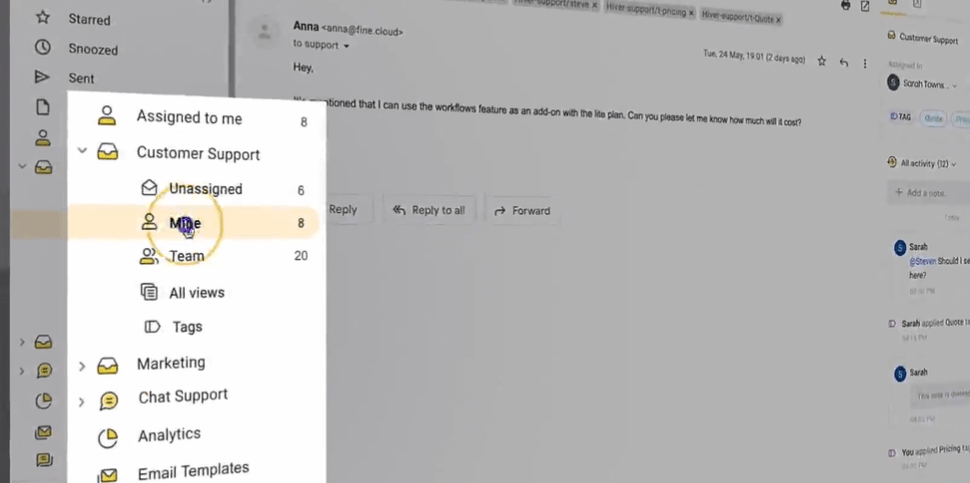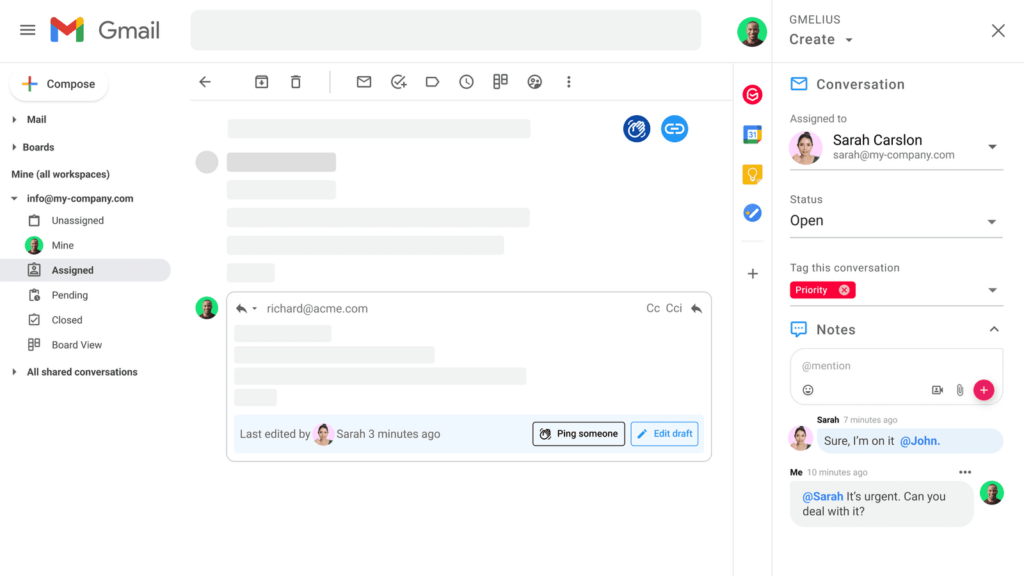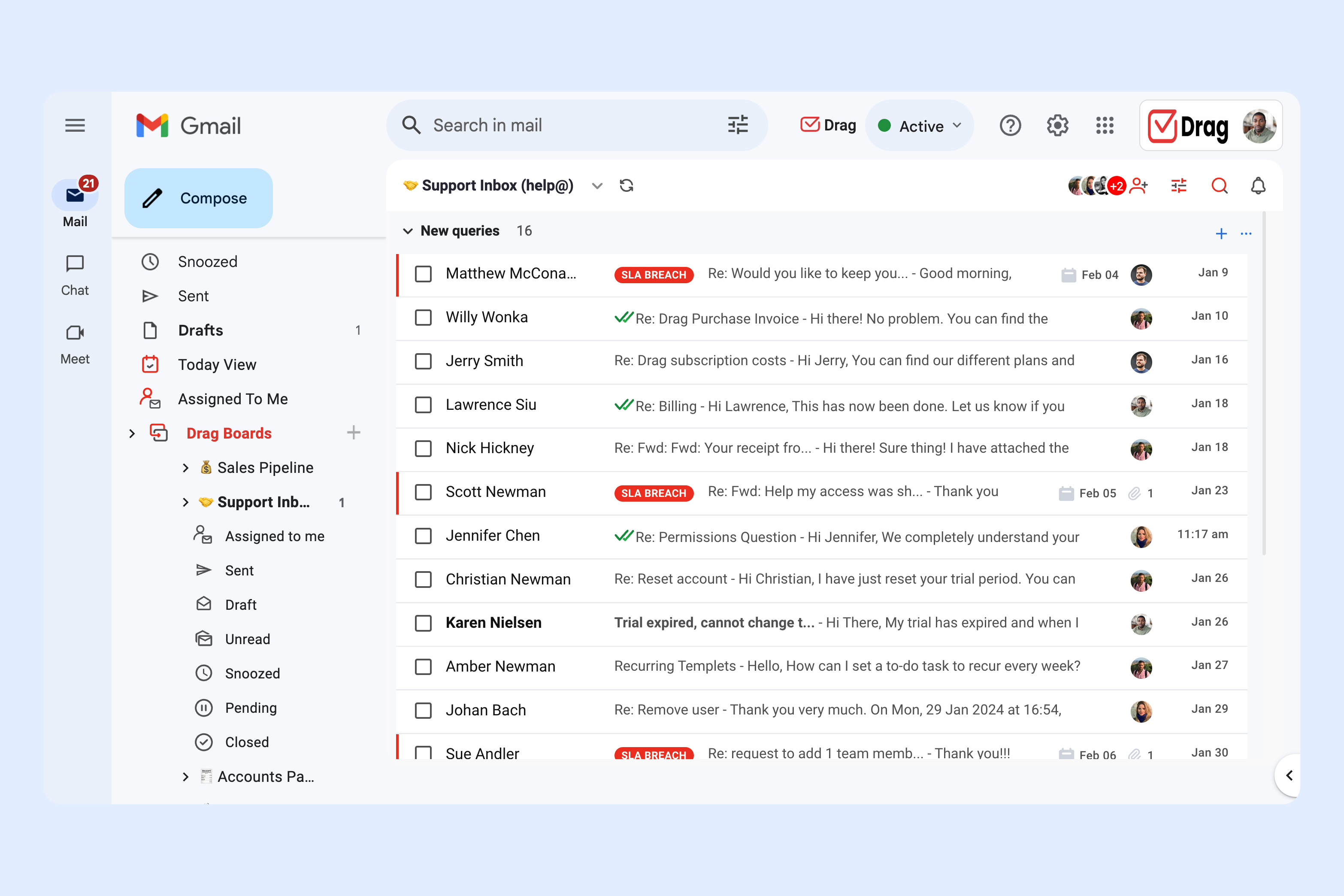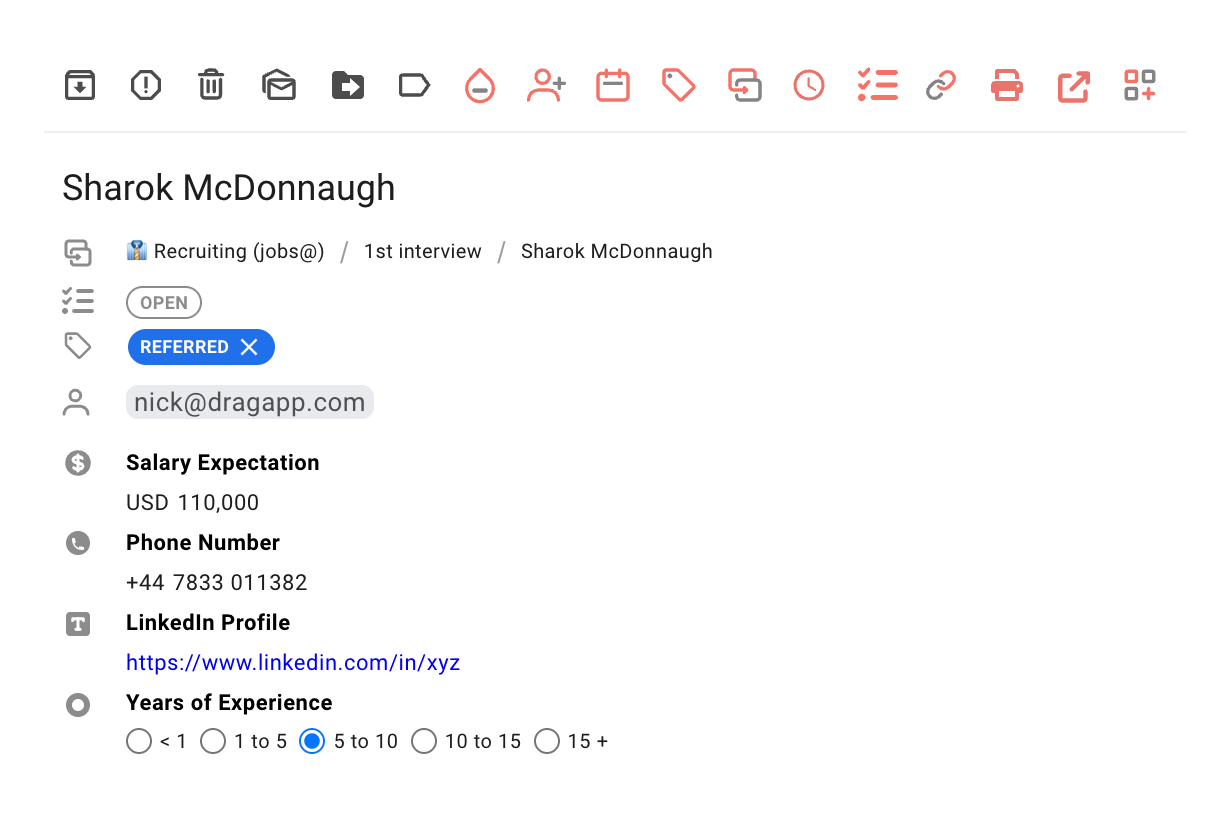
Knowing the right tools for your workflow is key to making it happen as smoothly as possible. That being said, with the plethora of options in the market, it might take some research to find the ideal ones.
In this article, we’ll explore Hiver vs Gmelius, two common choices among Google Workspace users, to find out which one could help your company.
Looking at them from afar, Hiver vs Gmelius isn’t an obvious choice. Each one has specific features that mesh better with certain teams, but not as well with others.
Besides, you need to consider the prices, software integrations, learning curve, user experience, and, of course, if either Hiver or Gmelius would work – or if you might need another tool.
Why to use a shared inbox tool
But first, let’s understand why the tool choice is an important factor in today’s digital workflow. Most businesses rely on multiple forms of communication to keep their work organized, secure and accessible to all collaborators. With remote work and ease of connection with customers and vendors, these tools are growing even more.
Most work is email-driven
These tools are known as shared inbox software and they can help with a lot of your email-driven workflow. Here’s a scenario: you work in Sales or Marketing. You’re constantly messaging clients and collaborators from a sales@ or partners@ email account. There’s a fast turnaround there.
External communication
The same can be said for customer support teams. Professional email response time is a key metric. You need to enhance if you’re trying to grow your relationship with current and potential customers. That is: making sure your customers feel heard while keeping up with always-busy inboxes.
Hiver or Gmelius and many other tools, such as Drag, work by bringing collaboration and workflow automation into Gmail. That makes your workflow faster and less prone to errors, leading to a better reputation for your business. All of this from inside the tool your team already use: Gmail.
Key features to look for in a shared inbox
Whether you’re looking into implementing Hiver or Gmelius – or another alternative -, it needs to be compatible with your team’s needs. With that in mind, here are a few points to pay attention to when choosing:
Collaboration
Teams often need to work together to find a solution. Maybe it’s a customer service email reply that requires extra attention or a new project you’re working on. No matter what, there needs to be a collaborative space to work on.
Seamless collaboration is key in any shared inbox. This means users being able to log into a collaborative mailbox simultaneously, from their own accounts. Then, everyone can check for incoming mail, delegate tasks, start on their to-do lists and ask for help, if necessary.
@Mentions and tags
Bonus points if this space also comes with other collaboration tools. For example: customer service agents work with helpdesk inboxes and ticketing systems.
If they need to ask for help, on a traditional inbox, they have to forward long email threads. It’s much easier if you have the option to @mention another agent and upload relevant files to the ticket itself.
Automation
Some tasks can be repetitive and take too much of your time. For instance, answering FAQs when you’re trying to close sales can be a timewaster. But you don’t want to leave a potential client waiting for a reply.
Auto replies
Automations can be helpful on shared inbox tool such as Hiver or Gmelius.You can customize rules to send auto replies to inquiries with a certain keyword. Or instantly assign these messages to an agent.
Integration
For a tool to be really productive, it needs to work well with the tools your team already uses. That is, if you’re using Gmail, it’s important to set up software that uses Gmail to fulfil your workflow needs. That way, you won’t have to go through learning a whole new platform and resources.
Drag, for example, is an email extension that turns Gmail into a shared inbox. So it’s perfect for small and medium-sized business managers and their teams.
Omnichannel connections
Besides, it needs to actually connect with other platforms that are part of your work routine. One example is multi-channel shared inboxes: if you need to connect with clients over social media, that’s essential.
Value
While initial costs are important, other factors impact your value for money when choosing between Hiver vs Gmelius. Is there a free version? What are its limitations? Can you try for a short period to see if this software matches your work?
Upgrades and extra resources
Even after implementing the final version, there are other questions: how are the pricing options? How much extra do you have to pay for each user? Do the resources you need only come at the higher tiers?
But beware of feature bloat: some work management apps are heavy on resources with a higher price tag. Unless you are planning on using all of them, it might not be the justified choice.
Hiver vs Gmelius vs Drag pricing
Another point of attention is the cost of both tools. Whether you pick Hiver or Gmelius (or another option), the cost has to align with your budget.
Hiver’s Lite Plan starts at $19/user/month and it’s limited to two shared inboxes. However, it’s important to know that you’re limited to 10 users. If you need more seats, plans start at $49/user/month. Meaning: the cost can easily become prohibitive depending on your team’s size.
As for Gmelius, the plan that offers automation is the Growth plan. It starts at $24/user/month. The shared inboxes are unlimited here. But there’s a catch: you only get 10000 shared messages per month. So if you have a high ticket volume, Gmelius can be limiting.
For comparison, Drag’s Starter plan costs $8/user/month, with no limits on shared inboxes and conversations. It also includes up to 10 automation rules. That means it can be more cost-effective for these teams.
Turn Gmail into your Team’s Workspace.
- 2.5x faster email responses.
- 20 hours less spent per month, per team member.
- 40% more deadlines achieved and happier teams.
Hiver: the good and the bad

Hiver is a multi-channel helpdesk inbox that centralizes all your communication. It can improve both internal and external emails. For instance, by setting up Hiver, you can reply to customers faster, leading to overall better customer service metrics.
Hiver vs Gmelius: What Hiver does better
Due to its multi-channel nature, Hiver allows users to interact across different points of contact. Some teams, such as marketing, find this resource useful. That is, you’re able to reach customers on social media, search for keywords, set up message campaigns, etc.
Gmelius, on the other side, only offers collaboration in email, and not on other channels.
The issues with Hiver
The kay concern with Hiver is that it’s not customizable enough. Yes, it makes use of existing Gmail filters and tags. But it’s hard to personalize your inbox to fully fit your needs. One of the reasons for this is that it doesn’t offer Zapier integration for the lowest pricing tier.
So, for example, you need to connect your email to your accounts payable software to fulfill invoices. But you can’t take advantage of automatically feeding the documents into it. Instead, your accounting team would have to manually export them from the mailbox. This isn’t prohibitive for smaller teams, but as the work routine grows, so does the need for app connectivity.
Hiver also doesn’t offer custom fields across any plans. Custom fields are paramount to enable users to create tailored workflows for their needs.
Gmelius: what you need to know

Gmelius, on the other hand, is a well-known contender for teams who prefer a streamlined, automated workflow. With these tools, you can set up automation tools that filter your incoming and outgoing mail to process it better.
So, for example: automatically sending current tasks to specialists, forwarding to other departments, workload distribution and much more.
Hiver vs Gmelius: What Gmelius is better at
Generally, the selection from Hiver or Gmelius depends on what your company needs. Customer service agents might benefit from Hiver’s helpdesk system, but Gmelius is far more flexible. Case in point: it includes Zapier and HubSpot integrations from the lowest tier. Virtually making it connected to most other tools you might need regularly.
It also offers a Kanban board view. Kanban boards are standard with project management. Instead of seeing all your current tasks as emails or lists, they are categorized in boards. So you can drag and drop tasks when you finish them and your entire team can follow the progress.
What Gmelius is lacking
While Gmelius is a popular choice, there are some cons to consider. The first is a free option, especially since Gmelius is already more expensive when you look at Hiver vs Gmelius.
And yes, the shared inbox tool on Gmelius is great. However, it still lacks some customization. You can’t add specific fields to represent your company roles, different departments or ongoing projects.
DragApp: true shared inbox in Gmail
Drag is another shared inbox tool built into Gmail. With different workspace views, users can view their shared inboxes in Kanban, list or preview views.
It also users to create custom task cards with space for private notes, shared comments and file uploads. That way, you can work together without ever leaving your own inbox.
Security
The first way Drag differs from Hiver and Gmelius is by the way the email collaboration was built by design. Both Hiver and Gmelius built their architecture similarly. When an email is sent to a shared inbox, a copy of the email is sent to every individual user’s inbox.
This means that you can’t stop users from forwarding emails externally, for example. Or, if someone leaves the company or a specific team, they’ll still have everything on their inbox.
With Drag, when sharing an email account with other team members, you are actually sharing the permissions to access that account. These can be revoked with immediate effect, leaving no footprint on the users’ or shared inbox’ accounts.
Custom fields
Custom fields is another key feature in Drag not available in either Hiver or Gmelius. The allow teams to add fields specific to what their company needs.
Custom fields have all of the different field types that you may need to organize your shared workspaces. For example:
- short text
- numbers
- ID
- tags
Workspace views
Drag is the most customizable shared inbox in Gmail, including the ways teams can visualize their shared inboxes. In Drag, you can choose to view workspaces in traditional list view, preview view or kanban view.
In addition, there are pre-filtered views such as “Assigned to me” or “Overdue & Due Soon”. With these views, you’ll see centralized relevant information across all workspaces.
Hiver vs Gmelius: what should you choose?
Ultimately, Hiver can be useful for interacting with customers across channels. However, Gmelius is overall a more solid choice due to its integrations. And Drag offers a a better shared inbox experience where you already work: Gmail.
But selecting the best option for your business needs requires research and comparing. You need to make sure the tool you pick has the features you need. You can browse through app directories such as Capterra and G2 to find out more.
Turn Gmail into your Team’s Workspace.
- 2.5x faster email responses.
- 20 hours less spent per month, per team member.
- 40% more deadlines achieved and happier teams.










